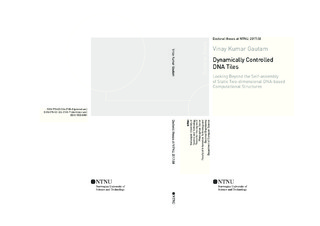| dc.description.abstract | Algorithmic self-assembly of DNA tiles enables computation and construction of DNA structures at the nanoscale, where the assembly process is guided by specific DNA interactions between complementary sticky-ends of tiles. Tile assembly was originally proposed as a unidirectional (passive) process, where tiles once assembled could not be disassembled and reassembled reliably and therefore, limiting its scope for designing complex, cheap and practically useful computational DNA systems.
A dynamically controlled tile assembly process would not only help in solving the limitations imposed by passive nature of tile assembly, but would also open up new avenues in biologically-inspired nanosystem design. However, enabling dynamic control in the self-assembly of DNA tiles — an attribute ubiquitous in the self-assembly happening at various scales in the living world — is a technical challenge.
This thesis addresses closely related issues of reliable and inexpensive assembly of tiles by combining DNA tiles and DNA strand displacement based dynamically controlled switching mechanisms. Building on the existing building blocks of the tile self-assembly, (self)-switchable and (externally)-switchable DNA tile structures are proposed.
Self-switchable tiles include Double Crossover DNA molecular structures and especially designed protection elements, together forming protected tiles termed Enveloped Tiles. Integrated protection elements of the Enveloped Tiles protect them from illegitimate binding as the tiles self-assemble cooperatively. A successful docking of correctly matching Enveloped Tile, which is favoured against the docking of a mismatched tile, releases its protection using an intramolecular DNA displacement process. The feasibility of the DNA molecular structure of Enveloped Tiles is established using DNA sequence design and thermodynamics calculations. The process of releasing protection of Enveloped Tile is studied using Coarse-grained molecular dynamics simulations. A kinetic modeling of the Enveloped Tile assembly process quantitatively demonstrates the error prevention feature. This work thus provides a theory-to-practice approach for a reliable construction of algorithmically self-assembling DNA tile systems.
Externally-switchable tiles are built around Double Crossover DNA molecular structures by adding a short DNA sequence with their sticky ends. The additional DNA sequences serve as switching points for the self-assembled tile structures that can be dissociated dynamically by a inhibitor DNA signal, which is generated by an integrated DNA reaction system. Using these tiles, therefore, hierarchical assembly pathways involving several steps of assembly, disassembly and reassembly can be designed. In this framework, we first introduce conceptual design of a minimal system for self-replication of algorithmically programmed DNA tile patterns and then study its behaviour using both the abstract and kinetic models of tile assembly. Simulations of the kinetic model, which capture the realism of the DNA tile assembly process, show that the tile pattern self-replication occurs reliably for a set of physicochemical parameters that are typically used in the self-assembly of tile patterns.
These switchable tile designs are simple, yet capable of assembling reliable and complexnanostructures without use of biological enzymes. Thus, in a more general view, these dynamically controlled self-assembly processes are useful for a wider class of applications in algorithmically programmable tile self-assembly systems. | nb_NO |
